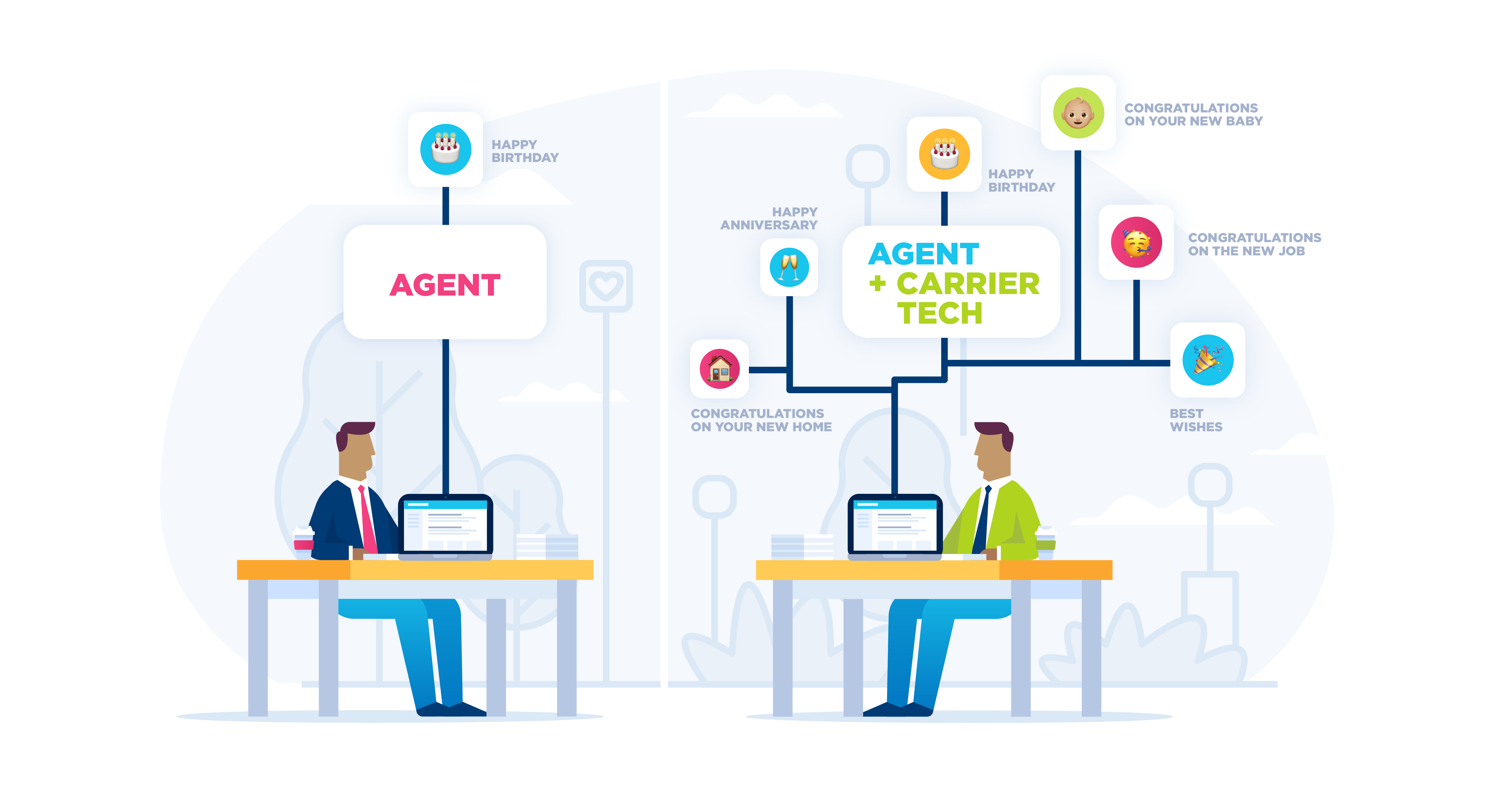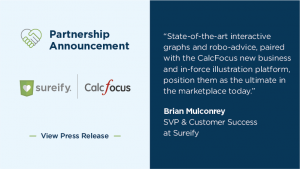There is one universal among all life insurance agents, though—they build their life insurance businesses to better the experience for policyholders.
Life insurance carriers offer various product lines and ways to conduct business. Some are almost wholly digital and need very few employees to meet the needs of buyers. Others rely heavily on a workforce of skilled employees who are trained to handle specific roles in the process of selling and servicing insurance policies.
And similarly, there’s one universal among all life insurance carriers—they build their life insurance businesses to better the experience for policyholders.
Now that we’ve established that both agents and carriers are on the same side, it’s much easier to see the “win-win” that comes from working together toward that goal of bettering the lives of policyholders. And if you think it’s naïve to say that both carriers and the vast life insurance distribution network are doing their work for the good of the customer, keep in mind—virtually every activity that both groups have undertaken in the last 10 years has been done largely, if not exclusively, for the purposes of improving the customer experience.
Despite this prospect of alignment, many agents remain uneasy about partnering with carriers. For those who thrive on meeting client demand and expectations, it should be an easy sell. But agents I’ve talked to have reservations about the carrier stepping into the relationship and deploying new technology to cross-sell or upsell.
Carriers, on the other hand, see the ability to communicate with the customer on behalf of the agent as a great way to enhance distribution in any form. A recent Capgemini article found that “many consumers are no longer valuing traditional distribution methods (such as face-to-face or voice-to-voice with captive life insurance agents) as much as they have in the past.” Additionally, with factors like COVID-19 and the nearly-universal embrace of a “work from home” model, the Capgemini survey found that “the distribution model (the customer and agent journeys and expectations, as well as agent readiness, rewards and recognition given the new modes of working) itself can also be outdated, which can lead to missed opportunities.” These missed opportunities may lack:
- Agent enthusiasm to sell new products/services
- Incentives for agents to sell/cross-sell
- Relationship building with the customer
These differing views may cause conflict between carriers (who ultimately provide the products and services) and agents (who sell the products and services). As each asks the question, “Who owns the customer, and, by extension, the opportunities associated with the customer?” each may come away with a different answer.
As a quick example, just a few years ago, agents took pride in their ability to personally connect with their customers, their policyholders. As a birthday approached, an agent might send a letter similar to the one below, hoping it would lead to new sales:
Dear Henry, I wish you the happiest birthday. Another trip around the sun, another chance to review your life insurance policy and be sure that beneficiaries and coverage amounts are up to date. Let’s talk soon.
Sincerely,
Your agent
This “concierge” touch that life insurance agents are famous for has always had incredible value, but it comes with a cost for the agent: time.
Imagine the modern agent. He or she is now regularly inundated by data that can reveal what every customer’s needs are on an hourly basis. One looked at houses on Zillow; one posted about a doctor’s appointment for a child; another is gearing up to run a marathon. Each of these factors imply a possible need to review life insurance coverage. But how can one agent address these countless opportunities?
A partnership between a digitally transformed carrier and an open-minded agent makes sense. But many agents still wonder if they will lose the personal connection when the insurer steps in.
Harnessing the power of data to deliver not just policies and service, but also engagement, is changing the agent universe. Those who sell insurance know that their role has always been, and continues to be, building relationships. New digital capabilities make it possible for an agent to send a quick note on mortgage protection, offer a policy for healthy children that can age with them, and congratulate them on being in such good health that they may qualify for better rates. And that’s just in the first 15 minutes of the day—and with minimal effort.
Agents may still need to be convinced that home office involvement is not home office interference or intervention. Smart insurtechs (like Sureify) are offering carriers ways to enhance their agents’ businesses. It is not a cutting out of the agent, but rather an augmentation of capabilities – delivering the right message to the right person through the right channel at the right time – and all with the knowledge and approval of the agent.
What can a carrier do to get a win?
As a carrier, there are steps you can take to allow and encourage those representing your product to meet their potential and grow their books of business:
1. Create a brand that’s known for being easy to do business with. As a life insurance carrier, you may have career agents. Or, you may rely on a network of independent agents. Either way, you want to make it easy for these agents to sell. If your brand has name recognition and an omni-channel presence, your agents have a gigantic head start. But implementing APIs and other technologies can give agents a new unique selling point—“We sell great products, but we protect you beyond your policy, keeping you informed of other products or services that you might need down the road, without you even asking.” The offer of ongoing help and counsel has incredible value.
2. Ease the process of selling. Any machine functions best when every part works at its maximum level of output with no friction. If you have digitally transformed to onboard new clients digitally, the agents that represent you should know that, and should be trained and given incentives to use that capability. An instant online check for eligibility, followed by a quote, and then a seamless way to usher them into the easiest way to purchase will enhance any customer’s experience. Your role as a carrier is to offer a front-end system that minimizes time requirements for onboarding, maintains end customer communications, and keeps everyone involved focused on the objective—a very personalized life insurance acquisition process.
3. Clear an agent’s schedule through back-end means. Self-service is critical—make it available and intuitive. Provide engagement that allows for personalization without tedious, time-consuming agent involvement. Enhanced digital engagement, done with the blessing and knowledge of your agents, will allow more time for your sales force to work on things that result in bottom-line wins for everyone.
4. Be willing to “co-own” the customer with the agent. As Capgemini points out: “Independent/non-captive/non-exclusive agents have the flexibility to offer various products from various companies with a better compensation model but present a challenge to insurers…their loyalty tends to be tied to compensation plans, ease of doing business with a particular carrier, and how a carrier’s underwriting standards match up to their client base.” Value to the agent has to be the foundation of everything offered by an insurer—from technology enhancement to communication, compensation to a visionary partnership for a future that benefits the carrier, agent and, most importantly, the customer.
What can agents do to get a win?
Agents who see a carrier’s use of technology as a way to enhance customer experience will use the inevitability of more involved carriers and new digital means of conducting business to flourish.
1. Remain engaged. Life should be about learning. An Aite-Novarica study looked at how agents can be innovators and leaders in distribution. They found that “Agents and brokers who understand where carriers are investing…can proactively engage and differentiate themselves in the distribution channel. Whether you exclusively represent a brand or have many options as a broker, remember that every digital transformation is done for the purposes of CX. That is your goal, too.”
The report also states: “While there are abundant InsureTech offerings in the market for carriers to embrace, insurers are often challenged with choosing capabilities that can be used and operationalized with agents and brokers. Rather than waiting for carriers to deliver new digital capabilities into the channel, agents and brokers can be proactive and take steps to engage insurance carriers early in development cycles and offer resources to prove out potential capabilities together.”
2. Maintain your focus on the policyholder or potential policyholder. Agents and agencies hold a “boots on the ground” position, especially for larger insurers. In this role, they offer a perspective that no amount of surveying can portray. Products, processes, and experience can be directly shaped to the needs of the distribution force—an agent’s individual role in this cannot be understated.
3. Appreciate the value that digital technology can bring to your book of business. In a 2017 report entitled Unlocking the Next Horizon of Growth in the Life Insurance Industry, McKinsey notes that “engagement at the time of life trigger events is critical for both mass-market and middle-market consumers—and financial advisers are essential to boosting purchasing rates. Life insurance companies can provide well-timed, personalized reminders or notifications around diet, disease management, doctor appointments, local health resources, and physical activity. Together, combining triggers with targeted outreach and engagement with a financial adviser increases the likelihood of purchase significantly.”
4. Be willing to “co-own” the customer with the carrier. The easy stuff—knowing a customer’s birthday or childrens’ ages—isn’t enough to heighten satisfaction anymore. Fortunately, carriers’ data-gathering capabilities will allow agents access to information about individuals in real time. And the interactions that result may very well generate interest in buying additional products.
A real-world example
Sureify has worked with several Top 10 life insurers globally to empower their sales forces—and the success has been notable! Here’s how one of our clients navigated the new territory:
1. They built and launched an app that had a significant policyholder communication plan. It reminded customers of the value of downloading the app, which included the ability to self-service their policies and review policy and financial wellness information. Just months after the launch, there was a significant increase in app downloads by policyholders. And interestingly, their monthly website logins doubled!
Key takeaway: This increased activity kept the brand—and the agent—top of mind, leading to more engagement, conversations and sales.
2. They used questionnaires to sync their app to CX and allowed their business to be shaped from the outside in, rather than from the inside out. When asked how they wanted to manage their policy, 50% of policyholders preferred the app, with 35% choosing the website. 15% said that either method was OK. This valuable information shaped a protocol of regular communication to the places preferred by each individual policyholder.
Key takeaway: Combining the app with the digitally-empowered agent allowed customers to be engaged on their terms—leading to a higher level of satisfaction and a higher Net Promoter Score.
3. They used findings to increase engagement. 80% of customers said that they would be willing to share life events with the company in return for recommendations from the insurer regarding changes to their financial plan. This kind of engagement through multiple platforms does more than simply retain customers. It helps guide customers to becoming advocates and eventually passionate supporters of the company, brand and agent. These results show the clear value of home office-producer communication collaboration. Customers who made a recent purchase were asked if the app had any bearing on the purchase. 75% of respondents said that the app:
- Reminded them to check into products that they had been considering
- Showed them gaps in their portfolio
- Provided blogs and articles with valuable financial education
Key takeaway: The value of this digitally-enabled, collaborative engagement with customers who downloaded the app led to an increase in new business for our partnering carrier!
This real-world story proves that a collaborative strategy between carriers who incorporate digital technology and the agents who offer their products will have “wins”. When the message to customers goes from “happy birthday” to “happy birthday, happy retirement, congrats on the new home, the new baby, the new job – now let’s get you insured,” with little extra time or effort needed, everybody wins.
The agent wins, with more inquiries that can lead to more sales from customers who already knew and liked him or her. The insurer wins by enhancing existing customer relationships with digital tools to bring in more cost-effective new business. And the policyholder wins with the right product offered at the right time through the right channels – and that means a better life insurance experience overall.





